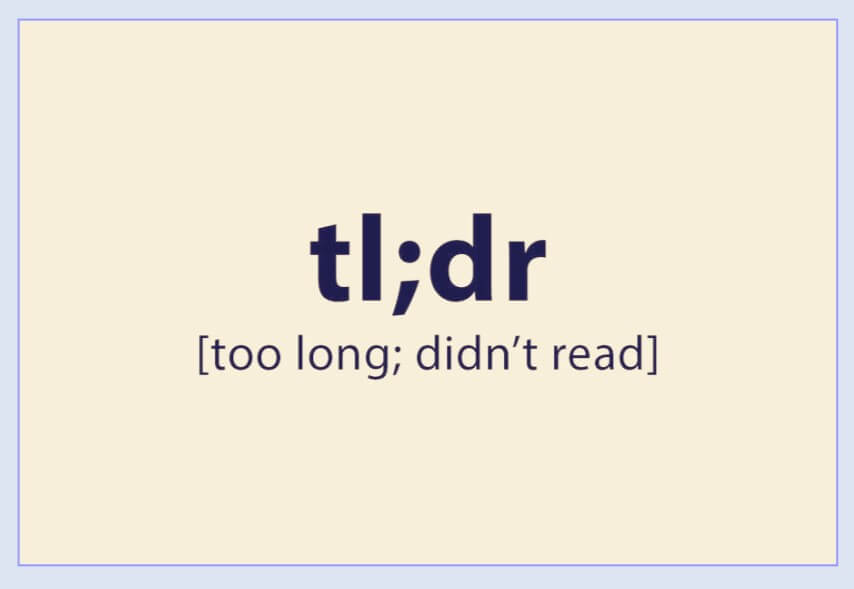What Does TLDR Mean In Texting? Comprehensive Guide to Meaning, Use & Example
TLDR is a term you might see a lot these days. It stands for “Too Long; Didn’t Read.” It’s a way to give a quick summary of a long piece of text. Fast-paced communication has made this term very important. You often see it on social media, emails, and articles. This article will cover what TLDR means, its importance, its origin, and how to use it.
What Does TLDR Mean in Texting?
In texting, TLDR is short for “Too Long; Didn’t Read.” It’s used to show that a piece of text is long and that a short summary would help. The meaning of TLDR is simple. It tells the reader to look for a shorter version. Or, it can be a way to offer a quick summary right at the start.

Origin of the Term
Where did TLDR come from? This term started as internet slang. People first used it on online forums and chat rooms. It quickly spread to other forms of communication like emails and social media. The term has been around for more than a decade. It has become a staple in mobile communication too.
Examples of TLDR
How do people use TLDR? Here are some examples:
- At the start of a long article, you might see a TLDR section. This section gives you the key points right away.
- In a text message or email, someone might write TLDR at the end. They give you a quick summary of what they’ve written.
- Sometimes, people use it to joke about something that is long and hard to read. For example, they might write “TLDR” after a long, boring legal document.
By using TLDR, we can share and get information faster. It helps us keep up with the fast-paced communication that is common today.
How Do People Use TLDR?
In Formal and Informal Settings
TLDR is a flexible term. People use it in both formal and informal settings. In a formal setting, like work, you may find TLDR in emails. Here, it serves as a quick snapshot of the main points. In informal settings, it often appears in social media posts and online chats. It helps the reader get the gist of a long story or rant quickly.
In Emails, Social Media, and Forums
People use TLDR differently in each platform. In emails, it is often at the top or bottom, summing up the main message. On social media, it may come at the end of a long post. It’s a way to respect the reader’s time. In online forums, it’s common to find a TLDR summary at the start of a lengthy article or discussion thread.
Examples of TLDR in Various Sentences
Here are some simple examples of TLDR:
- In emails: “TLDR: The meeting is moved to 3 pm, not 2 pm.”
- On social media: “I had an amazing trip! Saw so many places. TLDR: Vacation was awesome!”
- In forums: “TLDR: This new policy will affect all of us. Read the details below.”
The use of TLDR changes a bit depending on the sentence and platform. But the goal is the same: quick understanding.
Why Do People Use TLDR?
To Summarize Long Content
The most common purpose for TLDR is to summarize long content. We live in a fast world. Nobody has time to read pages and pages. TLDR gives us the main idea in a few seconds.
To Give a Quick Overview
Besides summarizing, TLDR can give a quick overview. Let’s say you get an email about a new company policy. If it starts with a TLDR, you know right away what to expect. It saves you time and energy.
For Humor or Sarcasm
People also use TLDR for humor or sarcasm. In some online chats or social media, you might see someone use TLDR in a funny way. For example, someone might post a very short story and add a TLDR that says, “Not much happened.” This use of TLDR makes people smile or laugh.
So, TLDR is more than just an abbreviation. It’s a tool that helps us navigate information faster. It saves us time, helps us focus, and even adds a touch of humor. Whether in an email at work or a post on social media, TLDR is there to make life a bit easier.
Is It TLDR or Other Variants?
Difference between TLDR, TLTR, and Tldnr
You may have seen TLDR, but did you know there are other variants too? These include TLTR and Tldnr. Though they look similar, they have small differences. TLDR stands for “Too Long; Didn’t Read.” TLTR is short for “Too Long To Read,” and Tldnr means “Too Long; Did Not Read.”
When to Use Each Variant
So, when should you use each variant? TLDR is the most widely used one. You’ll see it often in emails, articles, and social media posts. TLTR is less common. People usually use it in online communities to say a post is too long but not necessarily unread. Tldnr is the least common. It appears in forums where detailed discussions happen. It also has a slightly more negative tone.
TLDR Across Different Platforms
What Does TLDR Mean in YouTube, Reddit, and Other Social Media?
Now let’s look at TLDR across different platforms like YouTube, Reddit, and social media. On YouTube, TLDR often appears in the video description. It provides a summary of what the video is about. On Reddit, TLDR usually comes at the end of a long post. It helps the reader get the main points quickly. In other social media like Twitter or Instagram, TLDR is less common. This is because these platforms already have character limits.
Examples of TLDR on Various Platforms
Here are some examples to make it clear:
- YouTube: In the video description, you might see: “TLDR: This video teaches you simple cooking hacks.”
- Reddit: At the end of a long post, you might read: “TLDR: Tried five diets, Keto worked best for me.”
- Twitter: Though rare, you might come across a thread ending with: “TLDR: New policy changes are not user-friendly.”
Understanding TLDR and its variants can make your life easier. It helps you stay updated without getting bogged down by too much information. Whether it’s emails, forums, or social media, knowing the right variant to use can help you communicate better. This little term and its cousins, TLTR and Tldnr, serve as useful tools in today’s information-heavy world.
Other Contextual Meanings of TLDR
In Business, Relationships, and Life
TLDR is not just for online posts or articles. It has found its way into business, relationships, and even daily life. In a business setting, people use TLDR in emails or presentations. This helps to get the main point across fast. For instance, an email might start with a TLDR section that summarizes what the email is about. This can help busy people understand the core message without reading the entire email.
Crypto and Other Specialized Fields
TLDR has also entered crypto and other specialized fields. For example, someone might use TLDR to give a quick rundown of a complex blockchain concept. It can be a quick way to share key details without getting lost in jargon. Even in medical research, TLDRs can serve as short summaries of long, technical papers.
Alternatives to Using TLDR
Synonyms and Other Terms
Sometimes, TLDR might not be the best fit. Fortunately, there are alternatives. Terms like “In a Nutshell,” “Quick Take,” or “The Gist” can work well. They serve the same purpose but can be more suitable in certain contexts. For example, in a formal business report, using “Executive Summary” would be better than TLDR.
When to Use Alternatives
When should you pick an alternative to TLDR? If you’re in a very formal setting, a term like “Executive Summary” is a good pick. If you’re talking with friends, something casual like “Here’s the Deal” could be more fitting. The key is to know your audience and choose a term that fits the context.
TLDR-Related FAQs
What does TLDR mean?
TLDR stands for “Too Long; Didn’t Read.” It’s used to summarize lengthy content.
Is TLDR used in formal settings?
While TLDR originated in informal settings, it’s increasingly found in formal contexts like business emails to summarize key points.
Can I use TLDR in an email?
Yes, you can use TLDR in an email to provide a quick summary, especially if the email is long.
How is TLDR different from TLTR and Tldnr?
TLDR stands for “Too Long; Didn’t Read,” TLTR is “Too Long; To Read,” and Tldnr is “Too Long; Do Not Read.” TLDR is the most commonly used of the three.
Where else is TLDR used?
TLDR is used in various platforms like Reddit, YouTube, and other social media to summarize long posts or videos.
Is TLDR used in specialized fields like crypto?
Yes, TLDR is used in crypto and other specialized fields to summarize complex topics quickly.
What are some alternatives to using TLDR?
Alternatives to TLDR include “In a Nutshell,” “Quick Take,” “The Gist,” and “Executive Summary,” depending on the context.
When should I use alternatives to TLDR?
Use alternatives to TLDR when a more formal or specific term is better suited for the context, like “Executive Summary” in a business report.
What is the importance of TLDR?
TLDR is important because it helps readers quickly understand the main points of a long text, saving time and effort.
Can TLDR be used humorously or sarcastically?
Yes, TLDR can be used for humor or sarcasm, usually to highlight that a text could have been much shorter.
Do all articles or posts need a TLDR?
Not all articles require a TLDR. However, if the content is long and complex, a TLDR can help improve user engagement.
Is TLDR an internet slang?
While it started as internet slang, TLDR is now broadly used in various forms of written communication, both online and offline.
Conclusion
In our fast-paced world, TLDR plays a crucial role. It helps us get to the heart of a message quickly. Whether it’s for business, relationships, or specialized fields like crypto, TLDR and its variants make communication more efficient.
As we’ve seen, TLDR is not just an internet term. It’s a useful tool for making any form of communication easier to digest. So the next time you see or use TLDR, you’ll know its many meanings and contexts, and how to pick the right alternatives when needed.

